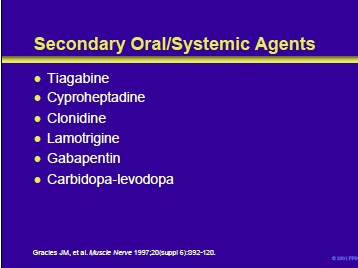
Tiagabine is primarily used for its antiepileptic activity but has also been employed in patients with spasticity. The precise mechanism of its action is unknown. However, it is believed to enhance the activity of GABA, the major inhibitory neurotransmitter in the CNS, predominantly by blocking GABA reuptake. Cyproheptadine is a 5-HT antagonist that may neutralize the spinal and supraspinal serotoninergic excitatory inputs.
It has been used in some patients with spasticity. Clonidine is a selective a2-receptor agonist that works at multiple levels. Its antispasticity activity may be due to enhancement of a2-mediated presynaptic inhibition of sensory afferents. Openlabel reports have described efficacy in patients with spasticity. Hypotension is a potential side effect.
Lamotrigine is an antiepileptic drug that blocks voltage and usedependent sodium channels and reduces the release of glutamate and other excitatory amino acids. These actions may decrease the manifestations of spasticity in some patients. Gabapentin is a GABA analogue with antiepileptic properties. It modulates the activity of enzymes that metabolize glutamate and may be useful in some patients with spasticity.
Carbidopa-levodopa is a combination of levodopa, a dopamine precursor, and carbidopa, a peripheral inhibitor of levodopa decarboxylation. This combination may be useful in patients with progressively worsening diplegia.
Gracies JM, Nance P, Elovic E, et al. Traditional pharmacological treatments for spasticity part II: general and regional treatments. Muscle Nerve 1997;20(suppl 6):S92-S120.
- Next Section : Intrathecal Baclofen for Spasticity in Cerebral Palsy

